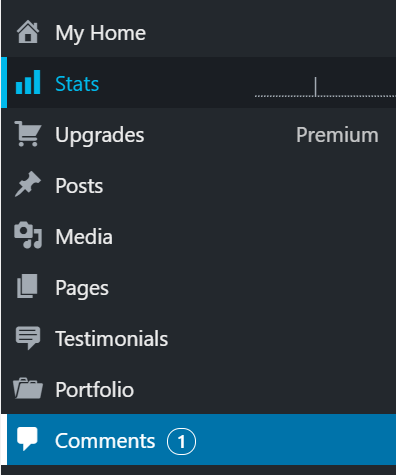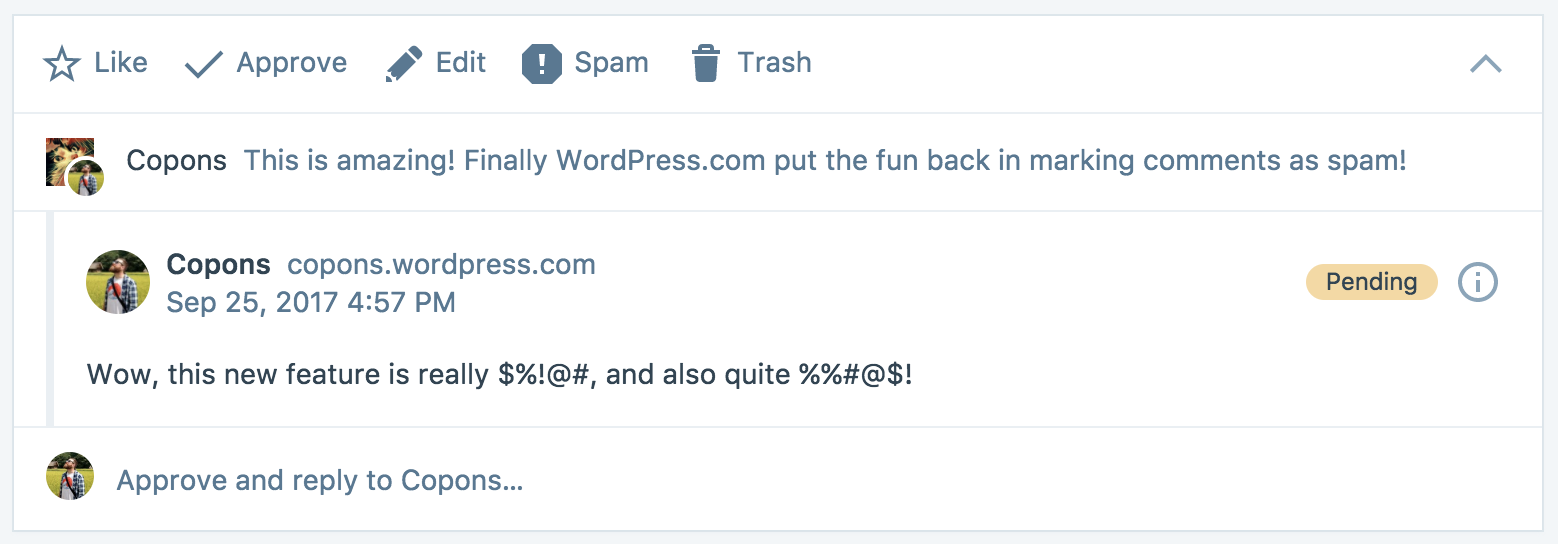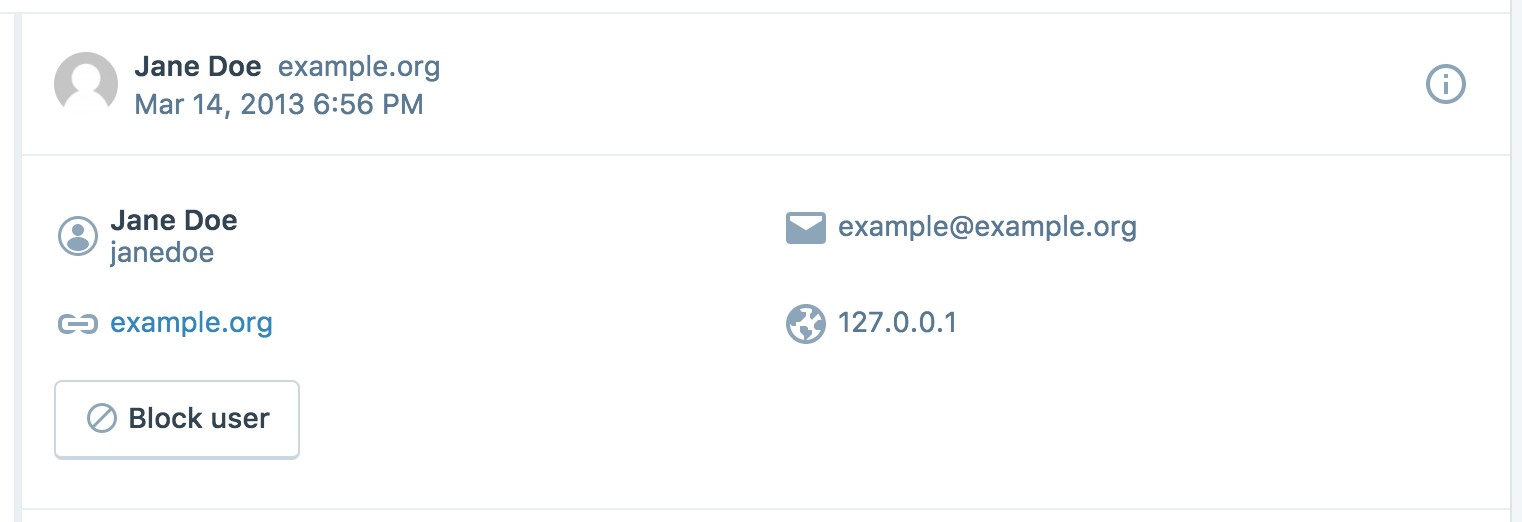How Long Until Domain Is Available Again After Refund Wordpress
Comments are a manner for visitors to add together feedback and reply to your posts and pages. If you choose to enable comments on your site, then a comment form will announced at the lesser for people to respond to what you have written.
Table of Contents
In Settings
You lot can enable or disable comments on all time to come posts by going to Settings → Give-and-take.
Under "Default Article Settings," toggle the option Allow people to mail comments on new articles on to enable comments, or off to disable comments.

On a Post or Page
You can enable or disable comments on a specific post you've already published. Follow these steps:
- Click on Posts or Pages in your dashboard.
- Click on the title of mail or page you lot want to enable or disable comments on.
- In the settings sidebar on the right, detect and open the Discussion tab.
- Select Allow Comments to enable comments, or deselect the option in club to disable comments:

On Pages, comments are disabled by default, only y'all can enable them using the setting every bit shown higher up.
For a Group of Posts or Pages
If yous would like to enable or disable comments for a group of posts or pages, get to WP Admin → Posts or WP Admin → Pages and follow the directions for Majority Editing.
↑ Table of Contents ↑
You can allow merely registered WordPress.com users to comment, or you can permit anyone to comment. If y'all permit anyone to comment, y'all tin choose whether the name and email fields are required or not.
These options are available on the Settings → Discussion screen:
- Comment writer must fill up out name and email
Makes the name and email accost fields required fields. These fields are only shown to someone who is not logged in to WordPress.com. - Users must be registered and logged in to comment
Use this option if yous only desire to allow comments from people who are logged in. This includes WordPress.com users, and all social network accounts. This prevents people from entering their own capricious details.
To learn more about all the available settings at Settings → Give-and-take, come across the Give-and-take Settings guide.
↑ Table of Contents ↑
To post a comment, open the private post and scroll to the bottom. As long equally the site owner has enabled comments, you'll see a box to write and share your comment.
↑ Table of Contents ↑
As the site owner, you are in consummate control of the comments left on your site. To see and manage comments on your site, click on Comments in your dashboard as shown here:

At the top of the Comments screen, you lot will find tabs for Awaiting, Approved, Spam, and Trashed, likewise as sorting options for Newest and Oldest, and Bulk Edit mode.

When viewing your list of comments, you lot'll encounter previews of the comments to make it like shooting fish in a barrel to browse them quickly. Pending comments (comments that have been submitted, only don't currently announced on your site) are highlighted in yellow, to make them easy to spot:


Clicking anywhere on a preview will expand information technology to brandish the total comment.
Here's an illustration of an expanded comment, followed past an explanation of its parts from top to lesser.

- Annotate actions: Like, Corroborate, Edit, Spam, Trash (see below for detail).
- Collapse comment details button: the lilliputian arrow in the upper right will close the comment dorsum down to the preview.
- A link to the blog mail or, if the annotate is a reply to another annotate, an excerpt of the original comment, so y'all have context for the chat.
- Comment author'due south name and website.
- Date and time the annotate was left.
- The awaiting label, if the comment is waiting to be approved.
- Additional user information button (see below for detail).
- The comment text itself.
- The answer option.
Boosted User Information
Clicking on the user info push volition open a new section containing additional data most the comment author.

The Cake User button will add together the comment author to the site blacklist, blocking them from writing new comments on your site.
You'll find all the deportment you can take on a annotate at the pinnacle of the expanded annotate. Apply these buttons to like/unlike, approve/unapprove, edit, mark as spam, move to trash, or permanently delete comments. Clicking Like or Corroborate one time volition perform those actions; clicking a 2d fourth dimension will un-do the action.

These actions are contextual and change depending on the comment status:
- Pending comments: Like, Approve, Edit, Marker as Spam, Move to Trash
- Approved comments: Similar, Unapprove, Edit, Marker as Spam, Motility to Trash
- Spam comments: Approve, Delete Permanently
- Trash comments: Approve, Marker every bit Spam, Delete Permanently
This is a view of a comment after clicking Edit on a comment:

Bulk Edit Way
Click on the Majority Edit button in the top right corner of Comments to enable the Majority Edit style:

Click anywhere on a comment to select it, and then perform actions on all selected comments at once. The actions include blessing, unapproving, deleting, and mark comments every bit spam all at once.

↑ Tabular array of Contents ↑
If your site has a lot of comments, it tin be useful to search through all of your site's comments to find a specific comment you're looking for.
These instructions are referring to the WP Admin interface. To view this interface, click the View tab in the upper right corner and selectArchetype view.
To search through your comments, follow these steps:
- Click on Comments in your dashboard.
- Using the search box at the summit of the screen, y'all tin search by keyword, the commenter'southward proper name, or the commenter'southward IP address.
↑ Table of Contents ↑
Unwanted Comments and Comment Spam
From time to time, you may receive unwanted comments on your site. There are many ways to protect your WordPress.com site from unwanted comments:
- All WordPress.com sites are protected by the Akismet comment spam filter, automatically marking spam comments for you. If yous observe that your comments are incorrectly marked equally spam, please contact Akismet support and mention that Akismet is communicable your comments by error.
- You can command whether comments are automatically approved or if they need to be reviewed earlier they are published. This makes sure no annotate is visible on your site wthout your approval.
- Yous tin can add rules for comment moderation to control which comments go marked equally pending approval
- You can add rules to the disallowed comments section to automatically mark some comments equally spam.
- If you turn on email notifications, and then y'all tin sentinel those messages for spam and delete them quickly if you discover any that get through the comment spam filter.
↑ Table of Contents ↑
It is not possible to edit or delete whatsoever comments you have left on other WordPress.com blogs. Blog owners are in full control of the comments on their blogs, then you lot can try contacting the blog owner and enquire them to edit or delete a comment for y'all. If the blog owner has non posted whatsoever contact information, you can effort leaving a short comment request how to contact them directly.
↑ Tabular array of Contents ↑
Additional guides and commenting features include:
- Discussion Settings
- Annotate notification emails
- Comment reply by e-mail
- Comment likes
- Embedding in comments
- Following comments by email
- Pingbacks
Source: https://wordpress.com/support/comments/
0 Response to "How Long Until Domain Is Available Again After Refund Wordpress"
Post a Comment